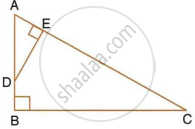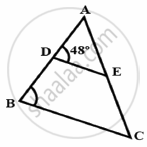Advertisements
Advertisements
प्रश्न
ABC is a right angled triangle with ∠ABC = 90°. D is any point on AB and DE is perpendicular to AC. Prove that :

- ΔADE ∼ ΔACB.
- If AC = 13 cm, BC = 5 cm and AE = 4 cm. Find DE and AD.
- Find, area of ΔADE : area of quadrilateral BCED.
उत्तर
i. Consider ΔADE and ΔACB
∠A = ∠A ...[Common]
m∠A = m∠E = 90°
Thus, by Angle-Angle similarity, triangles ΔACB ∼ ΔADE
ii. Since ΔADE ∼ ΔACB, their sides are proportional
`=> (AE)/(AB) = (AD)/(AC) = (DE)/(BC)` ...(1)
In ΔABC, by Pythagoras Theorem, we have
AB2 + BC2 = AC2
`=>` AB2 + 52 = 132
`=>` AB = 12 cm
From equation 1 we have
`4/12 = (AD)/13 = (DE)/5`
`=> 1/3 = (AD)/13`
`=> AD = 13/3 cm`
Also, `4/12 = (DE)/5`
`=> DE = 20/12 = 5/3 cm`
iii. We need to find the area of ΔADE and quadrilateral BCED
Area of ΔADE = `1/2 xx AE xx DE`
= `1/2 xx 4 xx 5/3`
= `10/3 cm^3`
Area of quadrilateral BCED = Area of ΔABC – Area of ΔADE
= `1/2 xx BC xx AB - 10/3`
= `1/2 xx 5 xx 12 - 10/3`
= `30 - 10/3`
= `80/3 cm^2`
Thus, ratio of areas of ADE to quadrilateral BCED = `(10/3)/(80/3) = 1/8`

APPEARS IN
संबंधित प्रश्न
In figure, `\frac{AO}{OC}=\frac{BO}{OD}=\frac{1}{2}` and AB = 5 cm. Find the value of DC.
D is a point on the side BC of ∆ABC such that ∠ADC = ∠BAC. Prove that` \frac{"CA"}{"CD"}=\frac{"CB"}{"CA"} or "CA"^2 = "CB" × "CD".`
Using Converse of basic proportionality theorem, prove that the line joining the mid-points of any two sides of a triangle is parallel to the third side. (Recall that you have done it in Class IX).
ΔABC~ΔPQR and ar(ΔABC) = 4, ar(ΔPQR) . If BC = 12cm, find QR.
State the SSS-similarity criterion for similarity of triangles
In ΔABC, point D divides AB in the ratio 5:7, Find: `"AE"/"AC"`
Two similar triangles will always have ________ angles
A flag pole 15 m high casts a shadow of 3 m at 10 a.m. The shadow cast by a building at the same time is 18.6 m. The height of the building is
Write the test of similarity for triangles given in figure.
In figure, if AD = 6cm, DB = 9cm, AE = 8cm and EC = 12cm and ∠ADE = 48°. Find ∠ABC.

